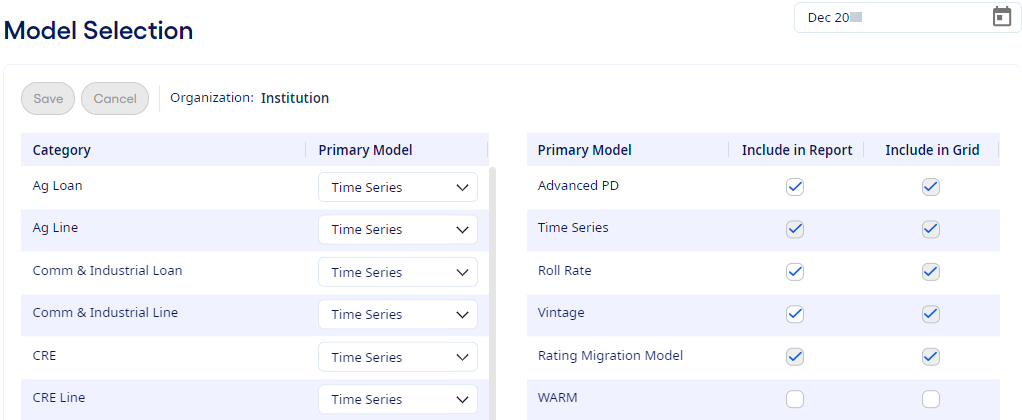Model Selection
You can assign a specific model to each loan category on the Model Selection page. The model is a specific current expected credit losses (CECL) calculation methodology.
Open the page from .
The CECL Analysis report uses the model that you select for each category.

You can select the following models:
-
Advanced PD - This model is the most sophisticated
credit loss model offered. It incorporates behavior characteristics unique to each loan
record, which affect loss expectations, and it uses the loss components of other models:
- Economic sensitivity (similar to the Time Series model)
- Product lifecycle (similar to the Vintage model)
- Roll Rate - This model calculates loss based solely on historical delinquency information with no consideration of economic factors.
- Time Series - This simpler model estimates expected future loan loss for each loan product based on correlations of historical loan loss to economic index rates. Correlations are calculated based on reported losses from historical call reports and various index rates in similar time periods.
-
Vintage - This model uses three components to estimate
future loan losses:
- Loan product lifecycle
- Historical loss
- Economic sensitivity to macroeconomic factors
- WARM - This model, which stands for weighted average remaining maturity, uses average annual charge-off rates and the remaining life of the loan to estimate the allowance for credit losses.
The Rated Loans category uses a single model, the Rating Migration Model, which you cannot change.
Include in Report and Grids
Model selections that you change and save on this page do not appear in your CECL Analysis report until the next time that your data is calculated and you receive the results.
For each model, you can use Include in Report and Include in Grids to determine which models are included in the CECL Analysis report and what model data you can see in the CECL Analysis grids. The settings work according to the following logic:
- By default, both columns are initially selected.
- When you select a model for at least one category, the model must appear in the CECL Analysis report and be available in the CECL Analysis grids. As a result, the model's Include in Report and Include in Grids check boxes are both selected automatically and are not editable.
- When you do not select a model for any category, you can still choose to include the model in the CECL Analysis report. If you include the model in the report, then the model's Include in Grids check box is selected automatically and is not editable.
- When you do not select a model for any category and you decide not to include the model in the CECL Analysis report, you can still control whether or not the model appears in the CECL Analysis grids.
Historical Settings
You can use the calendar to choose a historical month. When the calendar is used to choose a historical month, the settings on this page change to show the model and option selections that were in effect then.
CECL Model Data in the CECL Analysis Grids
Whether or not a model is included in the CECL Analysis report, you have access to the data for the model in the grids as long as the Include in Grids check box is checked for the model.
When you open the CECL Categories and CECL Details grids, the pairing of categories and models matches the Primary Model assignments from the Model Selection page. If you select a different model for a category in a grid, then the values in the Expected Loss columns change.
Lower-level categories all share the model selected for the parent category. If you change the model at a detail level, then the model change flows back to the top. When you return to the CECL Categories page, the parent category's setting reflects the model change made at the detail level.
Reports that are exported from the grids show the current model selections and the affected Expected Loss values.
Model selections in the grids are not retained when your session in the grid ends.